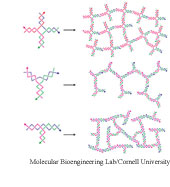|
NEWS
|
DNA sponges
 Synthetic branched DNA strands that connect to
form molecular webs produce inexpensive, biocompatible
hydrogels capable of encapsulating drugs and biological
materials, including living cells. The DNA hydrogels could
be used to deliver drugs, grow organs and other tissues,
and culture cells. (Enzyme-Catalysed
Assembly of DNA Hydrogel, Nature Materials,
October 2006)
Synthetic branched DNA strands that connect to
form molecular webs produce inexpensive, biocompatible
hydrogels capable of encapsulating drugs and biological
materials, including living cells. The DNA hydrogels could
be used to deliver drugs, grow organs and other tissues,
and culture cells. (Enzyme-Catalysed
Assembly of DNA Hydrogel, Nature Materials,
October 2006)
Chip charts gene action
A biochip combines microfluidics and fluorescent
gene expression indicators to track gene expression in
living cells over time. The chip has 256 tiny cell-containing
chambers that can each host an automated gene expression
experiment. The biochip could be used for drug development,
health care and basic science. (A
High-Throughput Microfluidic Real-time Gene Expression
Living Cell Array, Lab on a Chip, published
online September 29, 2006)
One-two nano punch
Biodegradable polymer nanoparticles that contain
water-attracting shells and water- repellent cores can
deliver drugs and DNA to cancer cells. The core-shell
nanoparticles were more effective at suppressing breast
cancer in mice than drugs or DNA alone. (Co-Delivery
of Drugs and DNA from Cationic Core–Shell Nanoparticles
Self-Assembled from a Biodegradable Copolymer, Nature
Materials, October 2006)
Biochip microscope
A biochip that sports a diagonal line of nanoscale
holes across a microfluidic channel is an inexpensive,
compact, lensless microscope. The biochip could speed
up, simplify and lower the cost of imaging cells and microorganisms
for medical diagnostics and research. (Optofluidic
Microscopy -- a Method for Implementing a High Resolution
Optical Microscope on a Chip, Lab on a Chip,
October 2006)
Gel-driven biochip
An inexpensive method of making temperature-sensitive
gels within microfluidic channels can be used to create
pumps and valves. The technique could be used to make
drug delivery devices that are triggered by changes in
body temperature. (Maskless
Microfabrication of Thermosensitive Gels Using a Microscope
and Application to a Controlled Release Microchip,
Lab on a Chip, October 2006)
Nanotech initiative report card
The National Academy of Sciences' National Materials
Advisory Board has issued a report assessing the National
Nanotechnology Initiative, the framework for guiding federally-funded
nanotechnology research and development. The report calls
for more research on environmental, health and safety
effects of nanotechnology; continued government support
of the initiative; the creation of an independent advisory
panel; better reporting of how funds are used in order
to assess economic impacts; and experimental data to determine
the potential of molecular manufacturing (A
Matter of Size: Triennial Review of the National Nanotechnology
Initiative, National Academy of Sciences, September
25, 2006) |
FEATURES
|
View
from the High Ground: ICL's John Pendry
Physics as machine tool, negative refractive
index, metamaterials, shattered wine glasses, higher capacity
DVDs, scientific backwaters, risk perception and practice,
practice, practice.
|
How
It Works: Quantum computing: qubits
Photons, electrons and atoms, oh my! These particles are
the raw materials for qubits, the basic building blocks
of quantum computers. |
|
 |
News RSS feed 
Blog RSS feed 
Bookshelf RSS feed

New: TRN's
Internet Services
TRN's Jobs Center
|
| |
| RESEARCH
WATCH |
| October
6 th, 2006 |
Northeast
climate heading south
In forecasting the effects
of global warming there are generally two
scenarios, bad and very bad.
A study by the Northeast Climate Impacts Assessment,
a collaboration between the Union of Concerned
Scientists and a team of independent scientists
from universities across the US, plots the
effects of global warming on the Northeast
in two cases...
September 21st, 2006
Female
faculty frustrated
August
8th, 2006
Highlights
from Siggraph
July
25, 2006
Cooked
wine
|
|
|
| |
|
| |
"Physics
is to the rest of science what machine tools are
to engineering. A corollary is that science places
power in our hands which can be used for good or
ill. Technology has been abused in this way throughout
the ages from gunpowder to atomic bombs."
- John Pendry, Imperial College London |
|
| |
|
| |
Thanks
to Kevin from
GoldBamboo.com
for technical support |
|

